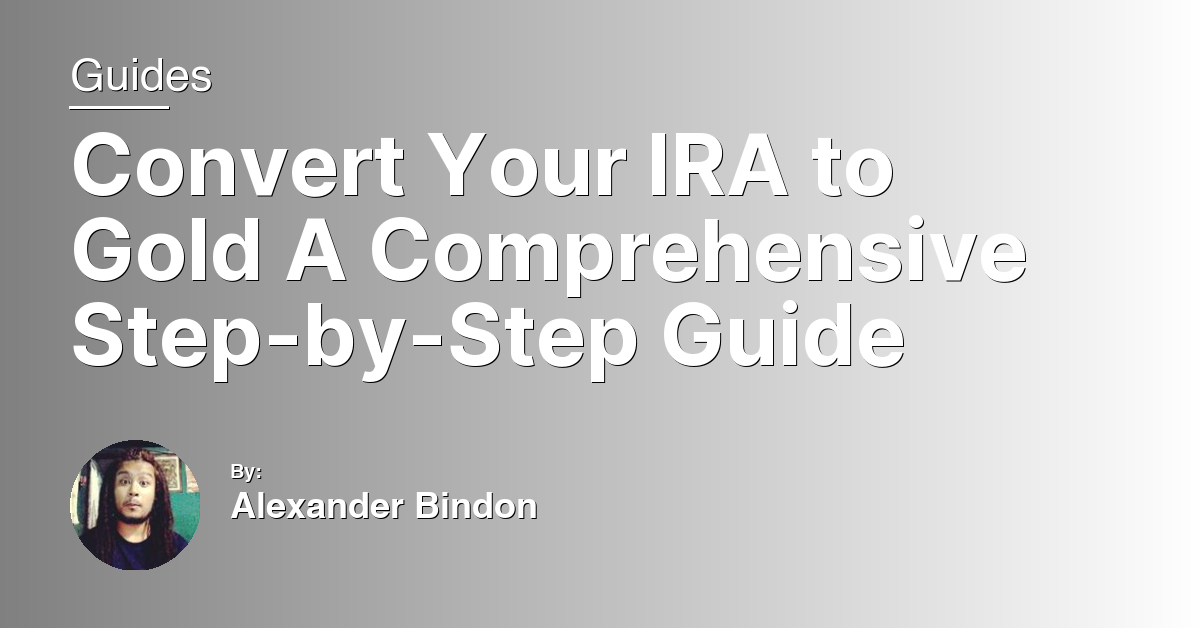In an era where financial security during retirement is more important than ever, diversifying your investment portfolio is key. Precious metals like gold and silver have historically been safe havens during economic uncertainties. This article will guide you through the process of incorporating these valuable assets into your retirement plan by investing through a Self-Directed IRA. Discover a path to potentially safeguard your future and ensure a stable retirement by exploring the benefits and how-tos of investing in gold and silver.
Opening a Self-Directed Gold IRA
To open a Self-Directed Gold IRA, start by choosing a reputable custodian approved by the IRS. This financial institution or broker-dealer will manage your IRA, ensuring compliance with tax laws and regulations.
It’s critical to select a custodian experienced in precious metals, as the rules for gold as an investment differ from more traditional IRA assets like stocks or bonds.
Next, you’ll fund your IRA. This can be done through a transfer from another IRA, a rollover from a qualified plan like a 401(k) or a SEP-IRA, or by contributing cash up to the annual limit. Remember, contributions may offer tax advantages, such as tax-deferred growth or tax-free withdrawals in the case of a Roth IRA.
Once funded, instruct your custodian to purchase gold or other precious metals like silver, platinum, or palladium. These can be in the form of bullion, coins, or possibly shares in a precious metal exchange-traded fund (ETF), depending on your custodian’s options and IRS regulations.
Investing in gold through an IRA can serve as a hedge against inflation and diversify your retirement portfolio, reducing risk in volatile markets. Always consult with a financial adviser to align this investment strategy with your retirement goals and risk tolerance.
Investing in Gold Through Existing IRAs
Investing in gold through an existing IRA, especially a Self-Directed IRA (SDIRA), allows investors to diversify their retirement portfolio with a tangible asset known for its stability and hedge against inflation. To begin, consult a financial adviser or broker-dealer who is experienced in the nuances of SDIRAs and familiar with the rules set by the Internal Revenue Service (IRS) for including precious metals like gold, silver, platinum, and palladium.
You can invest in gold through direct purchases of bullion or coins, or indirectly via gold ETFs (Exchange-Traded Funds), mutual funds, mining company stocks, or futures contracts. However, the IRS has specific requirements for physical gold investments, such as fineness standards and approved depositories for storage.
It’s crucial to understand the tax advantages, such as tax deferral, offered by IRAs, including SEP-IRA and Roth IRA, when investing in gold. Be mindful of potential fees and the need for a custodian to manage the IRA. Conduct thorough research or consult with a financial institution to ensure your gold investment is compliant and aligns with your overall investment strategy and retirement goals.
The Rules for Holding Physical Gold in an IRA
When holding physical gold in an IRA, it’s crucial to adhere to specific Internal Revenue Service (IRS) rules to maintain the tax advantages associated with these retirement accounts. Firstly, the gold must meet purity standards set by the IRS; for gold, this means a purity of 99.5% or higher.
Additionally, the physical gold must be held by a qualified custodian. This could be a bank, a non-bank trustee, or another entity approved by the IRS to act as a custodian for IRA assets. Direct possession by the IRA owner is not allowed, ensuring the security and compliance of the investment.
Transactions must avoid prohibited transactions, a set of rules designed to prevent self-dealing that could compromise the tax-deferred status of the IRA. This includes buying gold from or selling gold directly to the IRA owner or disqualified persons, like certain family members or businesses controlled by the IRA owner.
Finally, while physical gold can be a valuable part of a diversified retirement portfolio, investors should also consider other assets such as stocks, bonds, and mutual funds to hedge against market volatility and recession risks.
The Pros and Cons of Gold IRAs
Pros of Gold IRAs include offering a hedge against inflation and recession, as gold historically retains value even when the market declines. They diversify an investor’s portfolio beyond traditional stocks and bonds, including assets like gold coins and bullion. Gold IRAs provide tax advantages, similar to traditional IRAs, allowing for tax-deferred growth of investments.
Cons involve higher fees relative to other investment options, including costs for setup, storage, and insurance of the physical gold. There’s a limited selection of investment types; for instance, investors can’t include gold mining stocks or gold ETFs in a standard Gold IRA. Liquidity can be lower compared to stocks or mutual funds, as selling physical gold may take more time. Lastly, there’s potential for fraud, so investors need to choose reputable custodians and dealers.
Converting an Existing IRA to Gold
To convert an existing IRA into gold, you’ll primarily be transforming your traditional or Roth IRA into a Self-Directed IRA (SDIRA) focused on precious metals, an alternative investment strategy. This move allows investors to diversify their portfolio beyond traditional stocks, bonds, or mutual funds, tapping into the commodity market of metals like gold and silver.
Investing in gold through an IRA offers a tax advantage, including tax-deferred or tax-free growth, depending on your IRA type. To start, choose a custodian with experience in precious metal investments as the IRS mandates a qualified custodian for managing SDIRAs. This custodian will facilitate the purchase of physical gold, which must meet the IRS’s fineness standards, or gold assets like gold ETFs (Exchange-Traded Funds) and mutual funds.
Be mindful of fees involved in gold investment, including custodian fees, storage fees for physical gold, and potential transaction fees. Also, ensure the custodian’s credibility to avoid fraud. Investing in gold within your IRA is not just about adding gold coins or bullions; it’s a strategic move for asset diversification, offering a hedge against inflation and market volatility.
Contribution Limits and Regulations
When investing in gold and silver through a self-directed IRA, understanding the contribution limits and regulations is crucial. For 2023, the annual contribution limit is $6,000, or $7,000 if you’re 50 or older. These contributions are often tax-deductible, providing a significant tax advantage.
It’s important to note that investments must be IRS-approved; this includes certain gold coins and bullion but excludes jewelry and some collectible coins. Furthermore, the IRS requires that these physical assets be stored in a secure facility rather than at home.
Investing in gold and silver can be done through various vehicles within an IRA, including exchange-traded funds, mutual funds focused on the commodity market, and stocks in gold mining companies. Each option comes with its own set of fees and risks.
Lastly, always ensure your investments comply with U.S. Securities and Exchange Commission regulations to maintain the tax-deferred status of your IRA. Diversifying your retirement portfolio with gold and silver can serve as a hedge against inflation and market volatility, but it’s essential to stay within the legal framework to maximize benefits.
Physical Possession and Storage of Gold in an IRA
| Physical Possession and Storage of Gold in an IRA |
|---|
| When investing in gold through a self-directed IRA, you have the option to choose physical possession and storage of the gold within your account. This means that you actually own the physical gold and it is stored on your behalf in a secure facility. |
| There are strict regulations and guidelines that must be followed when storing gold in an IRA. The gold must be stored in an approved depository that meets certain requirements set forth by the IRS. This ensures that your investment is safe and secure. |
| It is important to do your research and choose a reputable custodian and storage facility to ensure the safety of your investment. Some custodians offer the option to visit the storage facility and inspect your gold in person. |
| By choosing physical possession and storage of gold in your IRA, you have the advantage of owning a tangible asset that can provide a hedge against economic uncertainties and inflation. It also gives you more control over your investment compared to other forms of gold ownership. |
F.A.Qs
What is the downside of a gold IRA?
The downside of a gold IRA is the additional complexities and expenses involved compared to conventional IRAs, such as purchase commissions, storage fees, and insurance costs, which can impact returns. Additionally, gold IRAs limit investments to IRS-approved precious metals.
Is a gold IRA tax free?
A gold IRA is not tax free. It is taxed at your income tax rate at the time of withdrawal, but contributions are not tax-deductible. However, you do not pay taxes on withdrawals from a gold IRA.
Can you roll an IRA into gold?
You can roll an IRA into gold by opening a self-directed IRA account, transferring funds, purchasing physical gold, and storing it securely.
What is the minimum to open a gold IRA?
The minimum to open a gold IRA varies depending on the company, with some requiring as low as $0 and others asking for $5,500 or more.

